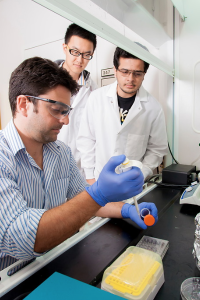Document Type
Article
Publication Title
Journal of Biomechanics
Abstract
Joint morphogenesis is an important phase of prenatal joint development during which the opposing cartilaginous rudiments acquire their reciprocal and interlocking shapes. At an early stage of development, the prenatal hip joint is formed of a deep acetabular cavity that almost totally encloses the head. By the time of birth, the acetabulum has become shallower and the femoral head has lost substantial sphericity, reducing joint coverage and stability. In this study, we use a dynamic mechanobiological simulation to explore the effects of normal (symmetric), reduced and abnormal (asymmetric) prenatal movements on hip joint shape, to understand their importance for postnatal skeletal malformations such as developmental dysplasia of the hip (DDH). We successfully predict the physiological trends of decreasing sphericity and acetabular coverage of the femoral head during fetal development. We show that a full range of symmetric movements helps to maintain some of the acetabular depth and femoral head sphericity, while reduced or absent movements can lead to decreased sphericity and acetabular coverage of the femoral head. When an abnormal movement pattern was applied, a deformed joint shape was predicted, with an opened asymmetric acetabulum and the onset of a malformed femoral head. This study provides evidence for the importance of fetal movements in the prevention and manifestation of congenital musculoskeletal disorders such as DDH.
DOI
10.1016/j.jbiomech.2015.06.002
Publication Date
6-30-2015
Recommended Citation
Giorgi, M., Carriero, A., Shefelbine, S. J., & Nowlan, N. C. (2015). Effects of normal and abnormal loading conditions on morphogenesis of the prenatal hip joint: application to hip dysplasia. Journal of biomechanics.


